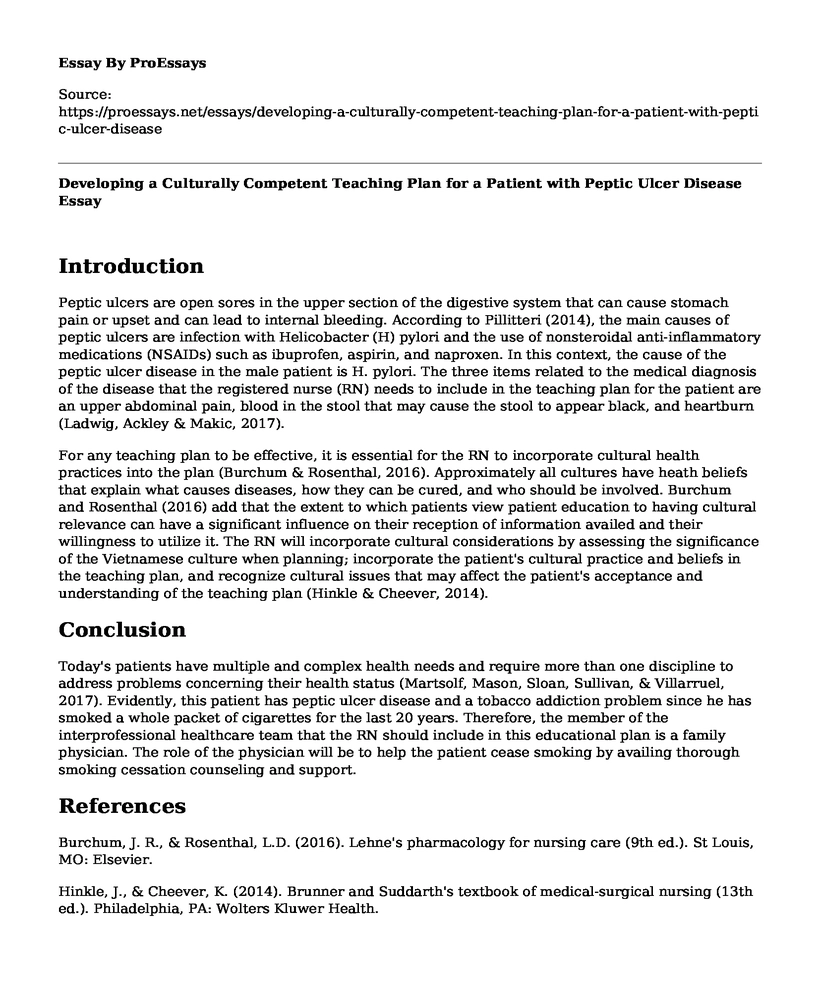Introduction
Peptic ulcers are open sores in the upper section of the digestive system that can cause stomach pain or upset and can lead to internal bleeding. According to Pillitteri (2014), the main causes of peptic ulcers are infection with Helicobacter (H) pylori and the use of nonsteroidal anti-inflammatory medications (NSAIDs) such as ibuprofen, aspirin, and naproxen. In this context, the cause of the peptic ulcer disease in the male patient is H. pylori. The three items related to the medical diagnosis of the disease that the registered nurse (RN) needs to include in the teaching plan for the patient are an upper abdominal pain, blood in the stool that may cause the stool to appear black, and heartburn (Ladwig, Ackley & Makic, 2017).
For any teaching plan to be effective, it is essential for the RN to incorporate cultural health practices into the plan (Burchum & Rosenthal, 2016). Approximately all cultures have heath beliefs that explain what causes diseases, how they can be cured, and who should be involved. Burchum and Rosenthal (2016) add that the extent to which patients view patient education to having cultural relevance can have a significant influence on their reception of information availed and their willingness to utilize it. The RN will incorporate cultural considerations by assessing the significance of the Vietnamese culture when planning; incorporate the patient's cultural practice and beliefs in the teaching plan, and recognize cultural issues that may affect the patient's acceptance and understanding of the teaching plan (Hinkle & Cheever, 2014).
Conclusion
Today's patients have multiple and complex health needs and require more than one discipline to address problems concerning their health status (Martsolf, Mason, Sloan, Sullivan, & Villarruel, 2017). Evidently, this patient has peptic ulcer disease and a tobacco addiction problem since he has smoked a whole packet of cigarettes for the last 20 years. Therefore, the member of the interprofessional healthcare team that the RN should include in this educational plan is a family physician. The role of the physician will be to help the patient cease smoking by availing thorough smoking cessation counseling and support.
References
Burchum, J. R., & Rosenthal, L.D. (2016). Lehne's pharmacology for nursing care (9th ed.). St Louis, MO: Elsevier.
Hinkle, J., & Cheever, K. (2014). Brunner and Suddarth's textbook of medical-surgical nursing (13th ed.). Philadelphia, PA: Wolters Kluwer Health.
Ladwig, G., Ackley, B., & Makic, M. (2017). Mosby's guide to nursing diagnosis (5th ed.). St. Louis, MO: Elsevier.
Martsolf, G., Mason, D. J., Sloan, J., Sullivan, C. G., & Villarruel, A. M. (2017). Nurse-Designed Care Models.
Pillitteri, A. (2014). Maternal and child health nursing: Care of the childbearing and childrearing family (7th ed.). Philadelphia, PA: Lippincott Williams & Wilkins.
Cite this page
Developing a Culturally Competent Teaching Plan for a Patient with Peptic Ulcer Disease. (2022, Jun 09). Retrieved from https://proessays.net/essays/developing-a-culturally-competent-teaching-plan-for-a-patient-with-peptic-ulcer-disease
If you are the original author of this essay and no longer wish to have it published on the ProEssays website, please click below to request its removal:
- Case Study Example of a Sepsis/SIRS Patient
- Alternative Therapies for Chronic Cardiovascular Conditions
- Nutrition Reflection Paper Example
- Essay Sample on Role of Epidemiology in Public Health
- Women's Access to Abortion Services - Essay Sample
- Unpacking Community Health Education Theory: Promoting Health Equity - Research Paper
- Faith-Based Nurses: Promoting National Health Objectives - Essay Sample







